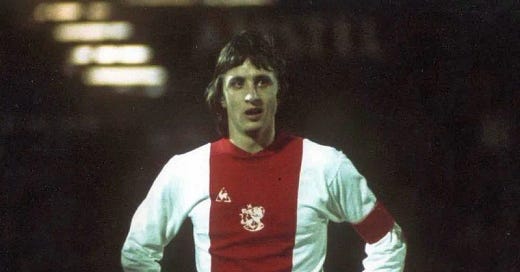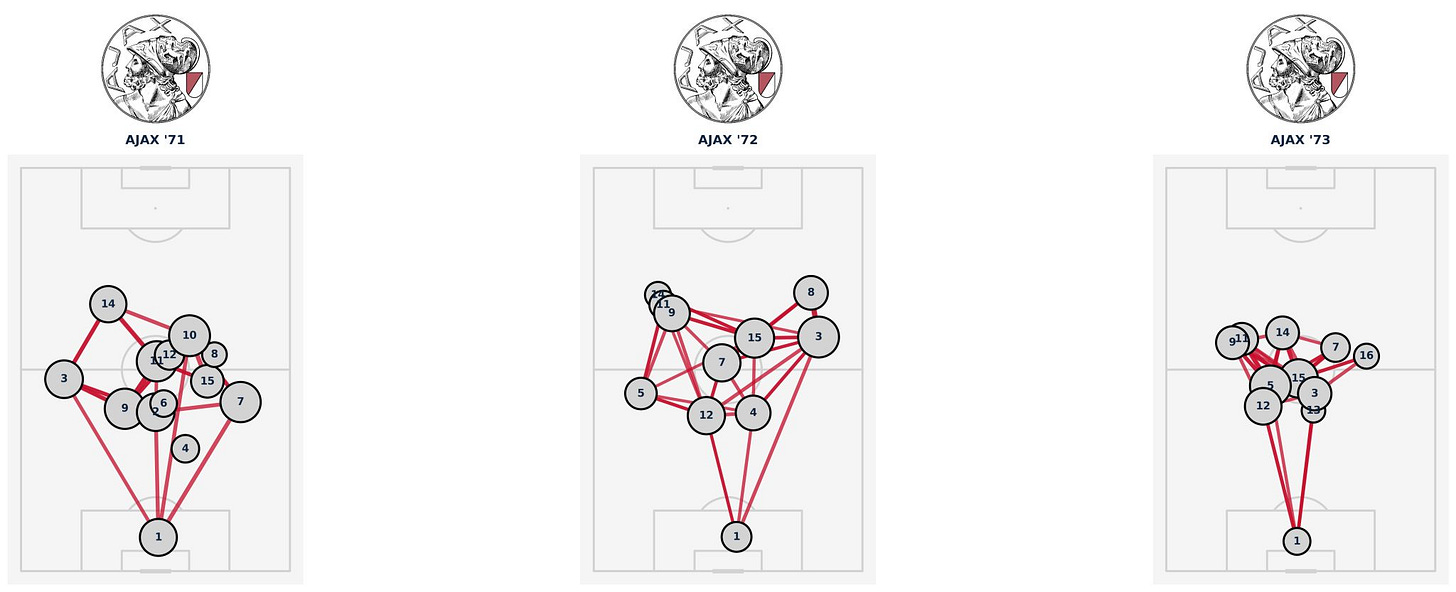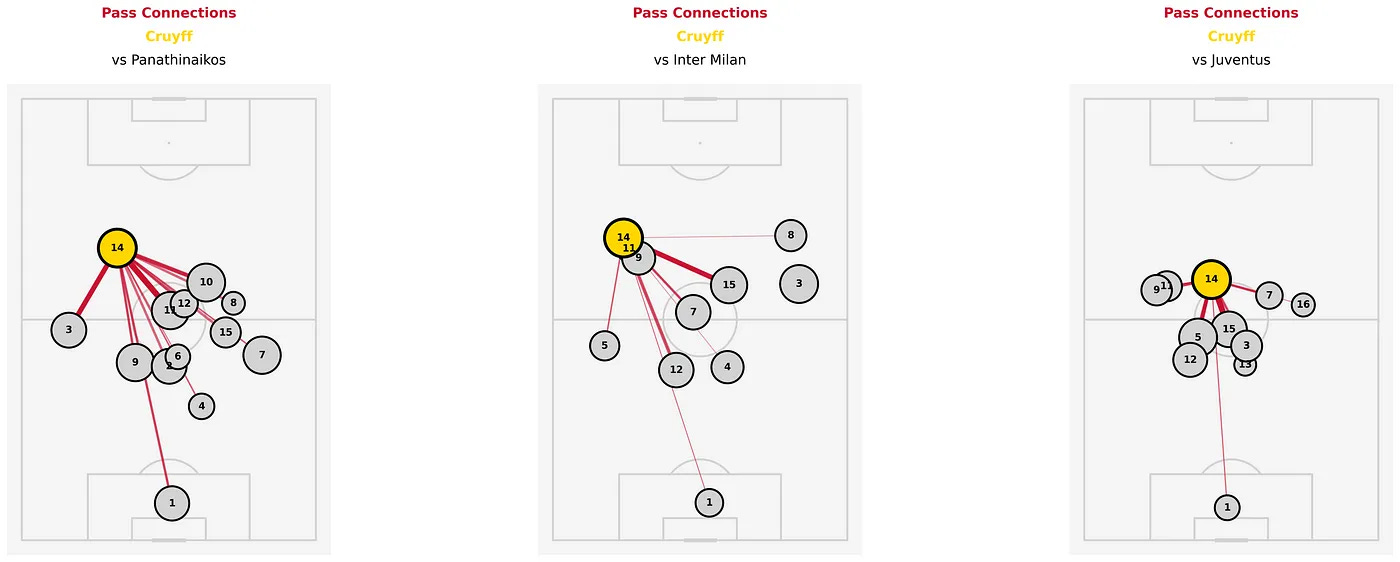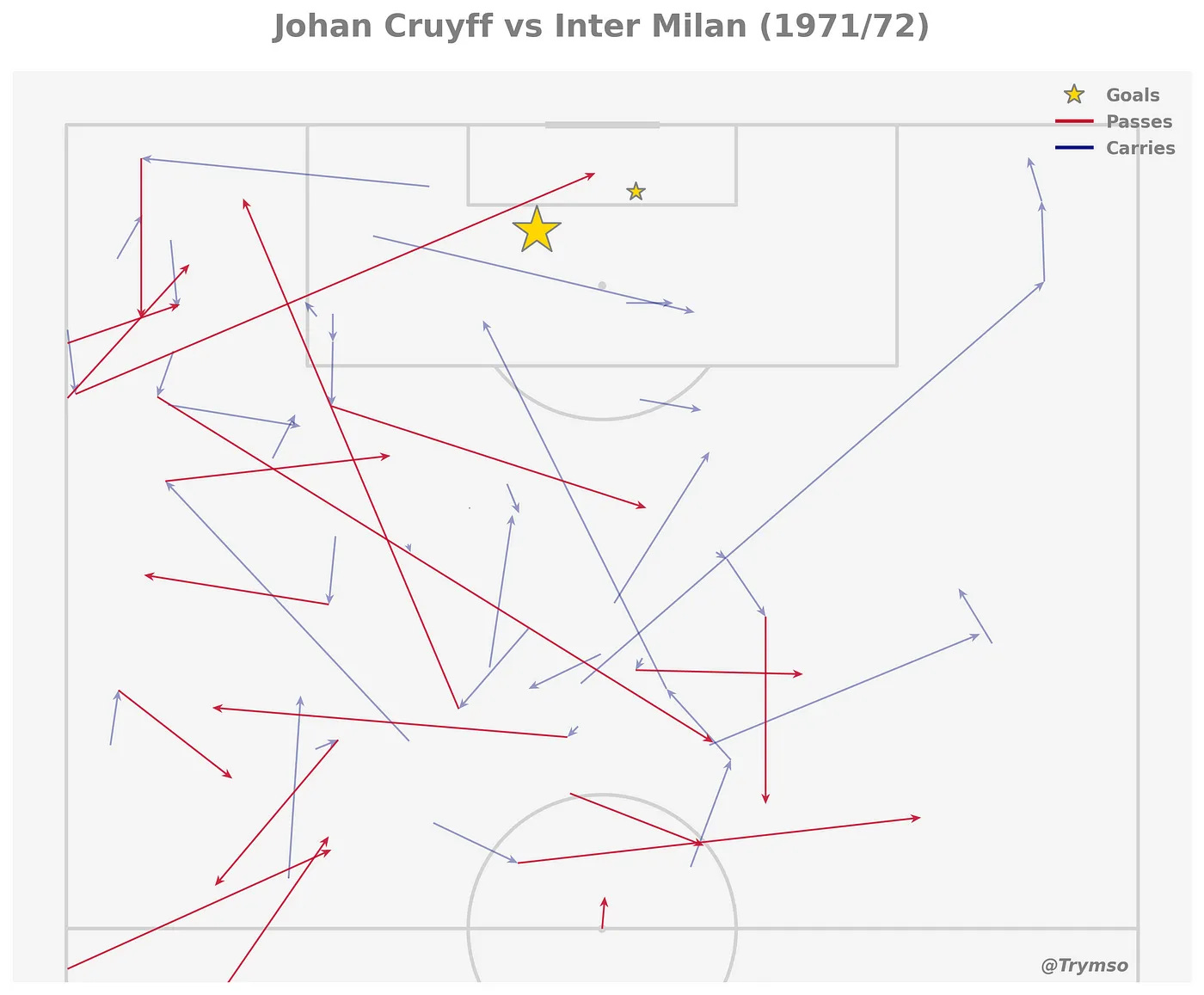“You play football with your head, and your legs are there to help you.” — Johan Cruyff
I love this quote from Johan Cruyff. With all the data available to us today, we can measure an incredible range of metrics in football. However, the most crucial skill — the art of decision-making, remains difficult to quantify.
The greatest players, like Cruyff, possessed extraordinary technical ability, but what truly set them apart was their incredible decision-making and movement on and off the ball. This is why we remember them. Cruyff didn’t just play football; he reimagined it. He dared to do things on the pitch that others couldn’t even conceive of, and every time he took the ball and dribbled past an opponent, it was, and still is, pure joy to watch.
This article takes a slightly different approach compared to my previous ones in the Data Scouting articles. Rather than crunching numbers, I’ll use data to create visuals from Cruyff’s time as a player at Ajax. StatsBomb previously released an Icons series featuring Cruyff, Maradona, and Pelé, and I’ll draw from this incredible resource to transport us back to the 1970s: a golden era when Ajax dominated Europe, winning three consecutive European Cups.
Ajax’s triumphs in the early ’70s introduced the world to Total Football and marked the end of the Italian Catenaccio era: a defensive and rigid style of play. In contrast, Ajax’s game was dynamic, fluid, and revolutionary, captivating football fans everywhere.
So, what exactly was Total Football, and what did it look like in action?
Total Football
Total Football was a revolutionary style of play that can be summed up in one phrase: everyone attacks, everyone defends.
What set Total Football apart was its fluidity and adaptability. Players could seamlessly interchange positions; if one player moved out of their position, another would instinctively fill the gap. This created a dynamic, free-flowing system with constant movement, all while maintaining a clear structural framework for where players were meant to be.
Rinus Michels (the pioneer and coach of the famous Ajax team) and Johan Cruyff later brought the principles of Total Football to Barcelona, where Cruyff built upon Ajax’s foundation as both a player and a coach.
Their philosophy deeply influenced the club’s identity, laying the groundwork for what we now recognize as Positional Play. Pep Guardiola, one of Cruyff’s most famous disciples, would refine and expand these ideas, transforming them into the sophisticated tactical system that defines modern football at its highest level.
The pass networks of these iconic Ajax teams are strikingly reminiscent of today’s top modern sides that prioritize ball possession, dominate in the opponent’s third, and press relentlessly to win the ball back immediately after losing it. What stands out is the evolution of their style over just three years.
In the first network from 1971, Ajax appears as a relatively expansive team in possession, with Johan Cruyff (#14) clearly positioned as the focal point in attack. His role as the main man up top highlights his central importance in driving the team’s offensive play.
By 1972, the network looks more balanced, with multiple players offering width and three players occupying the same average position as Cruyff. This suggests the essence of Total Football: players interchanging positions constantly.
The 1973 pass network, however, is the most fascinating. The players are so tightly connected that the network almost appears compact, reflecting a highly cohesive unit centered around short passing and close relationships.
Interestingly, we can see the presence of inverted fullbacks, a tactical innovation often credited to Pep Guardiola decades later. Additionally, Cruyff’s role had evolved significantly, as he moved more centrally over time, ultimately adopting the role of a false nine in the final year when Ajax triumphed over Juventus.
To better understand Cruyff’s role within the team, we can focus specifically on his pass connections.
From these visuals, we see that Cruyff initially operated more as a left winger or, more accurately, an inside forward, before gradually transitioning to a more central role. What remains consistent is his influence as the beating heart of the team. Cruyff had numerous pass connections, constantly seeking the ball and serving as the primary link between teammates.
In the next section, I have picked the game from 1972 when they beat Inter Milan 2–0 in the final.
Ajax vs Inter Milan 2–0 (1971/72)
I have to say it is pretty cool that we can go back in time to review xG numbers from this historic era. The game itself was relatively quiet in terms of chance creation during the first half. However, Ajax asserted their dominance in the second half, with Cruyff scoring both goals to secure the victory.
The first goal was essentially a tap-in to an open net, reflected by its high xG value. In contrast, the second goal, a well-placed header after a crazy leap, had a much lower xG, showcasing Cruyff’s ability to convert even difficult opportunities.
Fortunately, we have access to a high-quality video of the match, allowing us to relive these iconic moments and appreciate Ajax’s brilliance.
Enjoy!
You don’t have to watch the video for long to see who the protagonist on the pitch was. It’s so enjoyable to see a player like Cruyff, someone who consistently looked to challenge defenders every time he had the ball.
If I’m being honest, I think today’s game has become a bit too rigid and overly focused on positional play. We need more players with the freedom to express themselves creatively; not just for the beauty of the game, but also because it’s an incredibly effective way to disrupt and de-organize the opponent’s defense.
What stands out about Cruyff is his relentless attitude. Even when he loses the ball, it never seems to faze him. He just goes again every time. His defensive contribution is equally impressive, as he’s not afraid to put in the work, even sliding into tackles when needed.
What I particularly enjoyed about this game was the way Cruyff varied his play. He would drop deep to collect the ball and help build up play, but he also made intelligent runs in behind the defense, constantly keeping the opposition guessing. In other words, a constant threat.
The data tells the same story — Cruyff was everywhere. He scored, passed, and dribbled a lot! Players with this kind of influence are rare, though there are certainly other legends who come to mind. Naturally, names like Messi and Maradona stand out. However, when thinking about modern right-footed players, Eden Hazard feels like the closest comparison. Like Cruyff, Hazard had the confidence and flair to take on defenders, even in central areas, and possessed a similar fearlessness in his approach to the game.
Who do you think is the closest comparison to Cruyff in the modern game?
Conclusion
Working with this historical data and revisiting one of the greatest players in action was an absolute joy. Cruyff’s career was nothing short of extraordinary, and the legacy he left behind continues to shape modern football. He was truly special, a visionary and an icon of the game. To conclude, I want to leave you with one of his greatest quotes:
“Playing football is very simple, but playing simple football is the hardest thing there is.”
— Johan Cruyff
📧 If you enjoyed this post, I’d appreciate it if you would share it with a friend 🌟
🔗 I post regularly on my LinkedIn as well, so feel free to connect with me there 🤝
References
StatsBomb Icons: Johan Cruyff. (StatsBomb, 2024). URL: https://statsbomb.com/articles/soccer/statsbomb-icons-johan-cruyff/
Quotes Johan Cruyff (The Guardian, 2016): https://www.theguardian.com/football/2016/mar/24/you-play-football-with-your-head-and-your-legs-are-there-to-help-you-johan-cruyff-in-quotes









Cruyff didn’t just play football he reimagined it - that sentence alone is why there is no argument Cruyff is the greatest ever - completely redefined football on the pitch & then off it. Greatest ever
Hi Trym
Great article! You make an interesting point about the absence of creative play makers of the Cruyff mold in today's game. Given the current propensity for positional and structural adherence, how would you go about blending the two concepts? How do you shove a Cruyff type player into an orchestrated system?